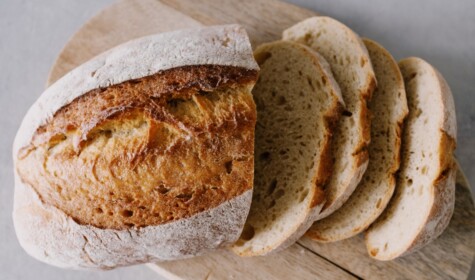Bread has always been at the heart of human history – we’ve been baking it for the best part of 10,000 years. But over the past decade there has been an explosion of people reporting problems with eating it. How could wheat, a staple food that has sustained humanity for so long, have suddenly become a threat to our health? What’s happened to wheat that is causing the increase in digestive disorders? And can we get back to the bread we ate for millennia without becoming wheat intolerant?*
The story that lies behind our problem with bread is a sad one. In the space of one century we abandoned both the flavour and nutrition of our most basic food in favour of producing vast amounts of cheap industrial loaves.
The impact of the Industrial Revolution
Bread remained almost unchanged for thousands of years. Then, from the late 1850s to the 1960s, every aspect of it changed. We didn’t just change the way we made it – we altered it to the point that our bodies no longer recognised the ingredients. A combination of the Industrial Revolution and the hybridisation of wheat fundamentally changed the nature of the flour we use for baking.
The problems we now face can be traced back to the middle of the 19th century, when Gregor Mendel developed what are now known as the laws of biological inheritance, or hybridisation. This revolutionary technique was quickly applied to wheat, but the grain was hybridised and developed not for its flavour, but for increased yields and levels of gluten. In doing so, we lost both taste and nutrition in our flour at an incredible speed. In just a few decades the gene pool was narrowed from thousands of varieties of to less than a hundred. It was the start of a monoculture.
Wheat didn’t just change in its genetic make-up. Towards the end of the 19th century there was also a major change in the way grain was processed and turned into flour. Up until this point all flour had been stone ground, a process that retained the wheat germ and its oils. This flour was fresh and had to be consumed quickly before the oils became rancid.
With the invention of the roller mill, wheat was ground with steel cylinders instead of stone. This very efficiently eliminated the germ – the richest part of the grain, containing proteins, vitamins, lipids and minerals. While the roller mill removed the most nutritious part of the grain, it produced white flour at high speed that could be stored for months on end without spoiling.
Additionally, as harvesting became increasingly mechanised, scientists developed wheat with shorter stems to accommodate the machines. Its root systems were also shorter and the gluten structure increasingly strong, giving modern bread its characteristic fluffy texture.
Changes in yeast
As wheat changed during the Industrial Revolution, the yeasts we use also underwent rapid scientific advancements. In 1876, two brothers, Charles and Max Fleischmann, launched their new, manufactured yeast at the Centennial Exposition in Philadelphia. By the 1930s, commercial yeast was firmly established as a household essential.
In the 1940s, as the United States entered the war, Fleischmann Laboratories were still leading the way in yeast development. They discovered and then manufactured Active Dry Yeast®, specifically so that the troops could enjoy home-baked bread. Scientists went on to develop highly active dry yeasts that were capable of raising dough up to 50% faster than regular yeasts.
In 1961, this leap lead to what many consider to be the low point of bread making: the arrival of the high volume Chorleywood baking process. This industrial method of factory-produced bread prioritised the speed and cost of production at the expense of flavour and texture.
The industrial process has been blamed for much of today’s wheat intolerance, as it produces bread that is full of enzymes and preservatives. But laying all the blame on the manufacturing oversimplifies the problem, given that the grains themselves have changed. The problem is not just how we make the bread, but also the kind of wheat we use to make it.
Heritage grain miller John Letts
As a specialist sourdough breadmaker, I have researched into old varieties of grains, to better understand their nutritional value and impact on digestion. My work introduced me to miller John Letts, who grows heritage grains in Oxfordshire, and as I began baking with his flour I realised the true social, environmental and health cost of industrial bread production. I began to bake sourdough bread using Einkorn and Emmer flours, and soon discovered that in contrast to modern wheat bread, the ancient grains have a deep nutty, sweet flavour and make robust loaves with great crust and light chewy interiors.
John Letts is a Canadian born archaeo-botanist who, for the past 25 years, has been growing and milling many of the heritage variety grains that have long since disappeared from industrial agricultural systems.
John’s dedication and passion is evident from the moment you meet him. In the garden behind his workshop are dozens of trial beds. The one that was looking the most lush was a gluten-free perpetual rye. John explained that heritage seeds are not like today’s varieties, which create a monoculture. John blends literally hundreds of different genetically diverse varieties, so if one particular kind doesn’t fare well in a particular spot, then another will. It’s a robust system, and one that, given the climate challenges we face, could well provide the answer to growing environmental problems, helping to build resilience in agriculture. Sowing a genetically diverse mix of seed also ensures that there is always a crop, because when one variety fails due to a virus or lack of rain, another will survive.
Old varieties have genetically evolved to grow on marginal land and are more likely to survive drought as they have longer roots so can seek moisture from deeper soil. These extensive root systems, which go down over a metre, also give them better access to micro-nutrients in the soil and the flour is more nutritious a result. This is aided by the mycorrhiza, microscopic fungi in the soil, which facilitate access to these trace minerals.
Chemical fertilisers, chromosomal differences and wheat intolerance
The absence of chemical fertilizers in much heritage grain production could well be the missing piece of the jigsaw puzzle. Most heritage grain is grown organically. Further, there is scientific evidence suggesting that varying levels of sulphur and nitrogen fertiliser can change the proteins in wheat, and proteins are at the heart of many allergies. One study found that increasing the level of nitrogen fertiliser directly resulted in increased levels of gliadin, a type of gluten protein that appears to cause the most allergic sensitivities. Chemical fertilisers also destroy the mycorrhiza fungi, which support the nutritional value of ancient grains.
Different types of wheat also have different numbers of chromosomes and there is evidence that these minute differences in chromosomes may be at the root of many digestive problems. There is wide anecdotal evidence that heritage flour is more easily tolerated than modern varieties, and there is compelling evidence from several studies to back up these claims, showing that older varieties of wheat, which have fewer chromosomes, also tend to have lower levels of gliadins.
The hybridisation of wheat and increased gliadin levels may well have contributed to the ever-increasing number of intolerances. But looking at the full picture, can we ignore the possibility that there is a connection between the massive increase in use of chemical fertilizers in the past 70 years and the significant increase in both gluten sensitivity and gluten allergies in the same period? Might it have contributed to the difficulty of digesting bread? Looking more closely at digestibility in bread, and why sourdough is important in this, could provide some insight – so keep an eye out for the next article exploring what makes sourdough bread more nutritious than yeasted bread and why it is easier to digest.
Vanessa teaches at The Sourdough School in Northamptonshire.
John Letts Lammas Fayre Flour is available from www.bakerybits.co.uk
*For the purpose of this article it is important to differentiate between intolerance, allergy and coeliac disease. An intolerance is generally a digestive malaise, with symptoms that can include headaches, nausea, irritability, bloating or IBS symptoms, whereas in cases of coeliac disease, the immune system mistakes substances found inside gluten as a threat to the body and attacks them, causing damage to the surface of the small bowel (intestines) and disrupting the body’s ability to absorb nutrients from food. Any form of wheat still contains gluten so it is strongly advised that coeliacs do not consume gluten.







